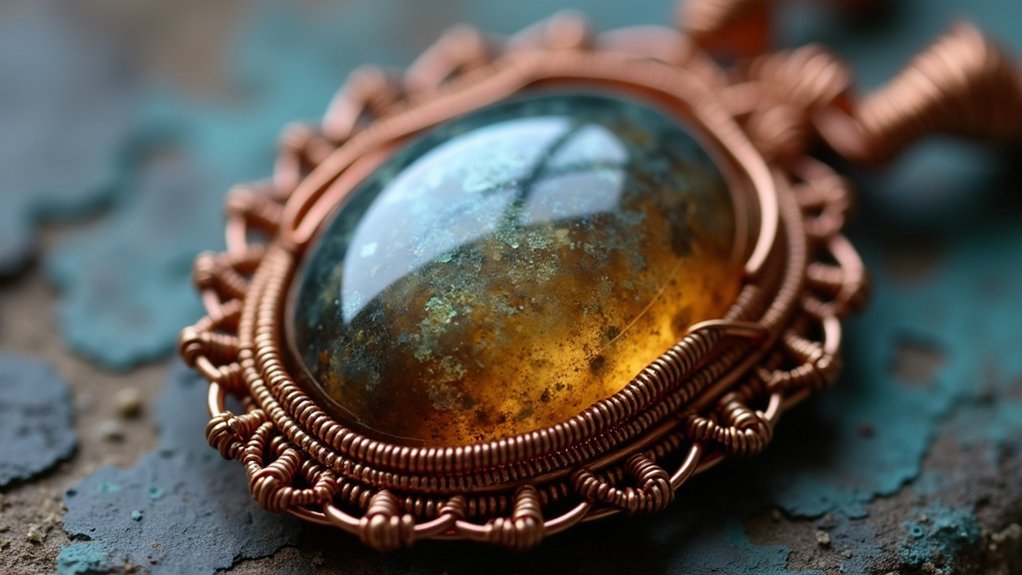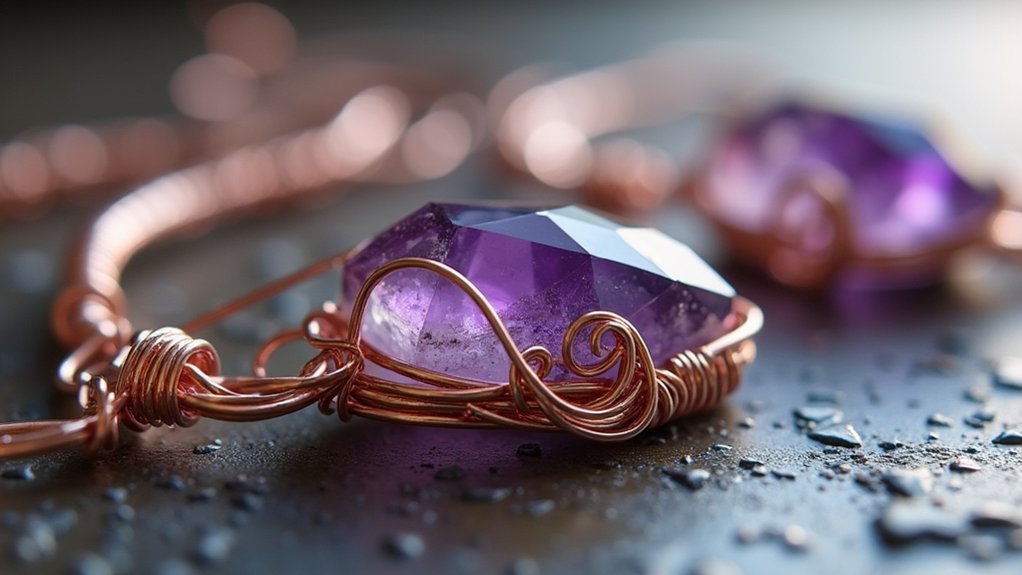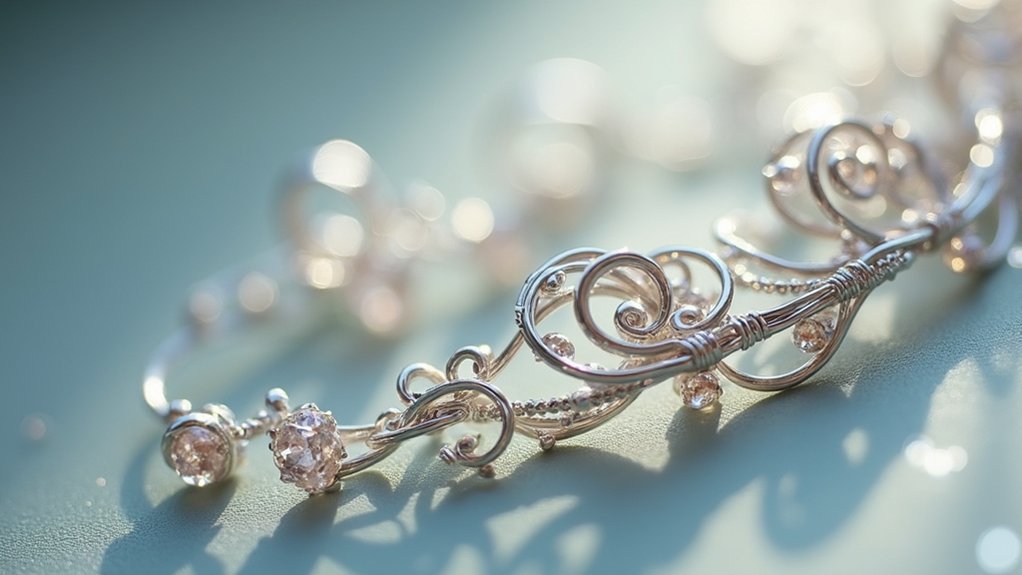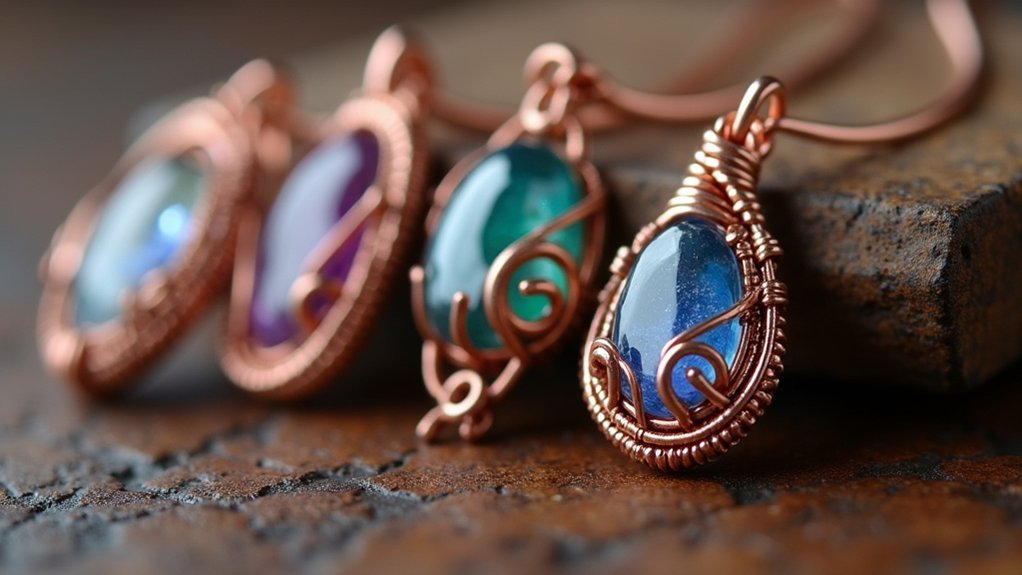Five advanced wire wrapping techniques to elevate your jewelry making include Woven Wire Bezel Setting for irregular cabochons, Multi-Wire Herringbone Weave for statement pendants, Sculptural Wire Caging for crystals, Advanced Bail Designs with integrated support structures, and Filigree Wire Methods for delicate pieces. You’ll need proper gauge selection, consistent tension, and specialized tools for each technique. Mastering these methods will transform your handcrafted pieces from basic wraps to gallery-worthy art.
Woven Wire Bezel Setting for Irregular Cabochons

Five essential steps transform irregular cabochons into stunning jewelry pieces through the woven wire bezel technique.
First, select appropriate gauge wire to create a custom frame that follows your cabochon’s unique contours. This advanced wire wrapping approach allows you to work with shapes that traditional settings can’t accommodate.
Wire gauge selection is the foundation of successful cabochon wrapping, unlocking potential for even the most challenging stone shapes.
Next, manipulate your wire into a base outline that perfectly matches your stone’s profile. Then apply figure-eight or herringbone weave patterns to secure the cabochon while adding textural interest. You’ll need to maintain consistent tension to guarantee structural integrity throughout the piece.
Don’t forget to leave extra wire length for final adjustments.
Once your stone is secured, enhance your creation by incorporating decorative elements like beads or twisted wire accents. These additions elevate your design while maintaining the cabochon’s visibility and security.
Multi-Wire Herringbone Weave for Statement Pendants
When creating dramatic focal pieces that captivate attention, the multi-wire herringbone weave stands as one of the most versatile techniques in a jeweler’s arsenal. This Wire Wrapping Technique transforms simple materials into sophisticated Wire Jewelry that commands notice.
Begin by selecting complementary wire pairs in your preferred gauge, forming a base loop to anchor your design. Create the distinctive pattern through alternating over-under movements, maintaining consistent tension for professional results.
Your Wire Wrapped Pendant gains dimension and character with each precise weave.
Don’t hesitate to incorporate beads or gemstones within your handmade jewelry piece—these additions elevate the design while showcasing your technical mastery.
As you practice this intricate technique, you’ll develop the skills needed to craft truly unique statement pendants that reflect your artistic vision while displaying impressive craftsmanship.
Sculptural Wire Caging Techniques for Crystals and Gemstones

Sculptural wire caging stands as the perfect complement to the herringbone weave, offering jewelers another dimension of artistry with raw crystals and polished gemstones.
This advanced wire wrapping tutorial focuses on creating frameworks that both secure and showcase your stones.
Begin by selecting 20-24 gauge wire, which provides ideal strength and flexibility for your wrapped jewelry pieces. You’ll create your cage by developing spiral or crisscross patterns around the stone, allowing light to penetrate while maintaining a secure hold.
As you develop your wire woven skills, experiment with combining techniques tutorials like herringbone weaves and twisted wire designs.
These methods create textured, artistic cages that transform simple stones into statement pieces. The beauty of sculptural wire caging lies in its versatility—each piece becomes uniquely yours as you practice and refine your techniques.
Advanced Bail Designs With Integrated Support Structures
Beyond just attachment points, well-crafted bail designs serve as both functional anchors and artistic focal points for your pendants. Advanced bail designs now incorporate integrated support structures that distribute weight evenly, greatly enhancing your pendant’s durability and stability.
Consider implementing the “Caged Bail” technique, which uses additional wire wraps to create a secure framework while maintaining creative expression. For heavier gemstones, opt for thicker gauge wire in your support structure.
The “Double Bail” design not only adds visual interest but allows for multiple chains while ensuring proper pendant alignment.
Don’t overlook decorative elements—twisted wire or bead accents can transform functional components into artistic features. When wire wrapping, these embellishments strengthen your piece while elevating its aesthetic appeal, creating jewelry that’s both beautiful and structurally sound.
Filigree Wire Wrapping Methods for Delicate Statement Pieces

The delicate art of filigree wire wrapping transforms ordinary jewelry into airy, intricate masterpieces that captivate with their complexity.
When working with this technique, you’ll need to select extremely fine wires—typically gauges 26-30—to achieve those signature lace-like patterns and decorative motifs.
Your precise tools make all the difference; invest in fine-tipped pliers and flush cutters to execute clean cuts and tight twists without damaging your delicate materials.
Create stunning statement pieces by combining your filigree wirework with carefully positioned gemstones as focal points, allowing your intricate craftsmanship to shine.
For structural integrity, consider reinforcing your designs with minimal soldering or adhesive. This preserves the lightweight appearance while ensuring your painstakingly crafted spirals and loops remain securely in place for years to come.
Frequently Asked Questions
What Is the Best Material for Wire Wrapping Jewelry?
You’ll find craft wire ideal for beginners, while sterling silver or gold-filled wire offers premium quality. Copper’s malleability makes it popular among artisans. Choose based on your budget and design requirements.
How Do You Make Jewelry Wire Harder?
You can make jewelry wire harder through work hardening—bend, twist, or hammer it repeatedly. Heat treatment also increases hardness. Choose lower gauge wire for naturally harder material, and use a wire jig for consistent shaping.
What Is the Best Wire for Wire Wrapped Rings?
For wire wrapped rings, you’ll want 20-24 gauge wire with an appropriate temper. Choose dead soft for intricate designs, half-hard for durability, and consider sterling silver or copper based on your budget and purpose.
What Gauge Wire Is Best for Jewelry Wrapping?
For jewelry wrapping, you’ll find 20-24 gauge wire works best. Use 20 gauge for structural elements and 24 gauge for delicate details. Consider your design’s needs—thicker wire provides support while thinner creates intricate patterns.
In Summary
You’ve now mastered five advanced wire wrapping techniques that’ll elevate your jewelry making to professional levels. By incorporating these woven bezels, herringbone weaves, sculptural cages, integrated bails, and filigree methods into your work, you’ll create truly distinctive pieces. Don’t be afraid to combine techniques or develop your own variations—that’s how you’ll establish your unique artistic voice in the competitive world of handcrafted jewelry.





Leave a Reply